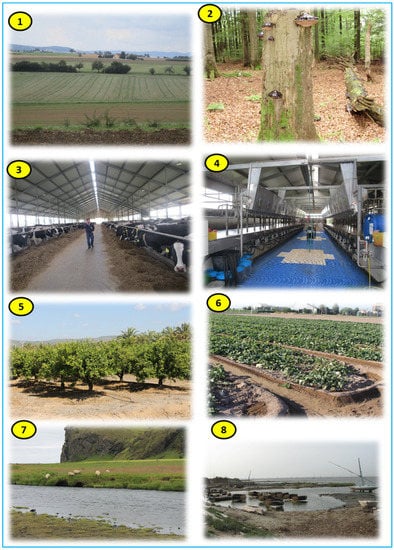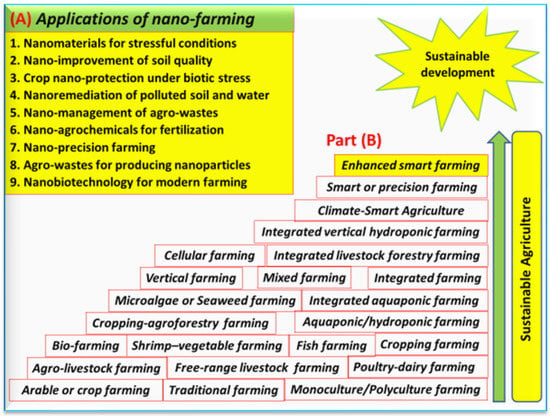Your browser does not fully support modern features. Please upgrade for a smoother experience.
Please note this is an old version of this entry, which may differ significantly from the current revision.
Subjects:
Others
The agricultural sector is a vital source of human well-being that provides the necessities of daily life. A variety of farming systems are utilized in agriculture, such as a wide range of tillage options, no-till, agroforestry, precision farming, organic farming, cover cropping, crop rotations, etc. Each of these farming systems has unique challenges, and nanotechnology has successfully improved on many of them. Agricultural applications of nanotechnology include nanofertilizers, nanopesticides, nanosensors, nanobiotechnology, and nanoremediation.
- nanopollution
- nanoremediation
- nano-priming
- nanopesticides
- precision farming
- nanotoxicology
- nanobiotechnology
1. Introduction
Farming includes growing crops and raising animals for food and raw materials, practices that are critical to human health and well-being [1][2]. To sustainably utilize agricultural resources, integrated farming systems should be established. Farming systems may include cropping, livestock, and agroforestry [3]. Types of agriculture include smart microalgae farming [4], seaweed farming [5], organic farming [6], agro-livestock farming [7], and mixed farming and agroforestry systems [3]. Farming has undergone a major transition over the last few decades for a number of reasons, including a global increase in population, urbanization, income growth, and development policies [8]. All opportunities for greater and more efficient production of cultivated crops and animals should be seized as many modern farms experience income stress [9]. Combined cropping and forestry farming can fuse economic and agroecological processes with temporal, spatial, and organizational integration across the farming enterprise [3]. Although intensive agriculture has increased food self-sufficiency, this has also led to rapid changes in the use of agricultural lands and affected the availability of water and its use [8]. Farming has many challenges due to climate change [10], eroding soil health [11], and global biodiversity decline [12]. Diversified farming systems incorporate different species and/or varieties of cultivated crops, fish, and/or livestock at multiple spatial and/or temporal scales to help address these challenges [13].
Nanotechnology has several applications in the field of agriculture [14]. The importance of nanotechnology has increased over time due to its fascinating solutions to overcome different obstacles (stresses) during the farming enterprise [15]. The application of nanomaterials (NMs) for farming practices is called “nanofarming”. Nanofarming can supply several sustainable solutions under both normal and stressful conditions [15]. These nanofarming practices may include the preparation of seeds by nano-priming [16], applying nanofertilizers for plant nutrition [17], using nanopesticides, and detecting phytopathogens with nanosensors [15][18]. Nanomaterials have also shown promise in supporting crops under stress in a sustainable manner [19]. Nanotechnology can improve crop quality and reduce post-harvest losses of agro-products by extending their shelf-life, particularly for vegetables and fruits [14]. There is also the possibility of using nanotechnology to generate sustainable energy from agro-wastes [20]. Removing pollutants from soil and water using nanoremediation is a promising technique to restore degraded agricultural soils under the nanofarming approach to achieve sustainable management of national resources [21]. However, the overuse of NMs during farming practices may lead to nanopollution [22]. Therefore, it is important that we understand the best ways to utilize NMs to enhance the conservation and restoration of degraded soil and water resources in agricultural systems without creating new problems.
2. An Overview
Farming involves growing crops (cropping) and keeping animals (animal husbandry) for the production of food and raw materials (Figure 1). There has been a global increase in intensive farming systems, which are characterized by their specialization and production on a large scale [3]. These specialized systems have produced foods in unprecedented quantities due to advanced agrochemicals, machinery advancement, breeding programs, and globalized supply chains [3]. Initially, this intensive agriculture led to a diminished threat of global hunger and malnutrition, but with challenges, such as the COVID-19 pandemic, climate change, and the increased number of conflicts over the last decade, the number of undernourished people and food prices is on the rise [23]. Approximately 10% (828 million people) of the world’s population was affected by hunger in 2021, an increase from 8% (678 million) in 2019 [24]. Given this development, it is desirable that we find new ways that will allow us to make additional progress so we can meet the United Nation’s goal of zero hunger [25].

Figure 1. Farming is an essential activity to produce food and feed for humans and animals. There are many different types of farming and farm management, such as (1) cultivation of grain crops, (2) agroforestry, (3) raising animals for meat production, (4) dairy production, (5) fruit production, (6) vegetable production, (7) sheep production for meat and wool, and (8) aquaculture. Photos (1–4) from Göttingen, Germany and 8 from Burullus Lake, Egypt by El-Ramady. Photos (5,6) from Spain, and (7) from Iceland by Brevik.
The simplest farming systems are cropping, livestock, and forestry systems. There are several combinations among these systems, and they can be integrated, such as integrated crop-livestock, livestock-forestry, crop-forestry, and crop-livestock-forestry systems [3]. Additional examples of farming system combinations can be found in Figure 2. It is very important to minimize the environmental problems that result from farming practices. This could be achieved by reducing the use of inputs (mainly agrochemicals) and replacing them with alternative management practices, such as zero-tillage and applying manure, and NMs as more eco-friendly practices [3]. Using nanoscale agrochemicals can significantly reduce the overall applied rates to the field and minimize the pollution caused by traditional agrochemicals [26]. These approaches are needed, especially in climate-smart agriculture [27].

Figure 2. The suggested applications of nanotechnology for different types of farming with the goal of achieving sustainable agricultural development (Part (A)). Part (B) presents different types of farming in a pyramid form, where common 20th-century large-scale practices form the base (e.g., monoculture farming) and sustainable practices are at the top (e.g., enhanced smart farming).
Nanomaterials have shown the potential to improve a number of practices or properties related to farming, including soil quality, smart fertilization, precision farming, production under stressful conditions, remediation of polluted soil and water, management of agro-wastes, and production of sustainable energy (Figure 2). Agro-nanotechnology has been recognized as a novel and innovative approach to developing sustainable farming practices that address a wide range of challenges (e.g., pollution and degradation, and climate change) facing modern farming [15].
This entry is adapted from the peer-reviewed paper 10.3390/agronomy13061600
References
- Steffan, J.J.; Brevik, E.C.; Burgess, L.C.; Cerdà, A. The effect of soil on human health: An overview. Eur. J. Soil Sci. 2018, 69, 159–171.
- Brevik, E.C.; Pereg, L.; Pereira, P.; Steffan, J.J.; Burgess, L.C.; Gedeon, C.I. Shelter, clothing, and fuel: Often overlooked links between soils, ecosystem services, and human health. Sci. Total Environ. 2019, 651, 134–142.
- Low, G.; Dalhaus, T.; Meuwissen, M.P.M. Mixed farming and agroforestry systems: A systematic review on value chain implications. Agric. Syst. 2023, 206, 103606.
- Lim, H.R.; Khoo, K.S.; Chia, W.Y.; Chew, K.W.; Ho, S.H.; Pau Loke Show, P.L. Smart microalgae farming with internet-of-things for sustainable agriculture. Biotechnol. Adv. 2022, 57, 107931.
- Sultana, F.; Abdul Wahab, M.A.; Nahiduzzaman, M.; Mohiuddin, M.; Iqbal, M.Z.; Shakil, A.; Mamun, A.A.; Khan, M.S.; Wong, L.; Asaduzzaman, M. Seaweed farming for food and nutritional security, climate change mitigation and adaptation, and women empowerment: A review. Aquac. Fish. 2023, 8, 463–480.
- Marino, S. Understanding the spatio-temporal behavior of crop yield, yield components and weed pressure using time series Sentinel-2-data in an organic farming system. Eur. J. Agron. 2023, 145, 126785.
- Lee, J.H.; Yun, S.T.; Yu, S.; Yoo, C.H.; Jeong, Y.S.; Kim, K.H.; Kim, H.R.; Kim, H. Development of an integrated hydrochemical index for delineating livestock manure-derived groundwater plumes in agro-livestock farming areas. Ecol. Indic. 2022, 138, 108838.
- Kuchimanchi, B.R.; Ripoll-Bosch, R.; Steenstra, F.A.; Thomas, R.; Simon, J.; Oosting, S.J. The impact of intensive farming systems on groundwater availability in dryland environments: A watershed level study from Telangana, India. Curr. Res. Environ. Sustain. 2023, 5, 100198.
- Elamathi, S.; Singh, S.; Rangaraj, T.; Anandhi, P. Integrated Farming System Model for Sustained Farm Income and Employment Generation Under Rainfed Vertisol of Southern Zone of Tamil Nadu. Natl. Acad. Sci. Lett. 2021, 44, 485–487.
- Yoon, P.R.; Lee, S.H.; Choi, J.Y.; Yoo, S.H.; Hur, S.O. Analysis of climate change impact on resource intensity and carbon emissions in protected farming systems using Water-Energy-Food-Carbon Nexus. Resour. Conserv. Recycl. 2022, 184, 106394.
- Choudhury, B.U.; Nengzouzam, G.; Islam, A. Evaluation of climate change impact on soil erosion in the integrated farming system based hilly micro-watersheds using Revised Universal Soil Loss Equation. Catena 2022, 214, 106306.
- Lomba, A.; da Costa, J.F.; Ramil-Rego, P.; Corbelle-Rico, E. Assessing the link between farming systems and biodiversity in agricultural landscapes: Insights from Galicia (Spain). J. Environ. Manag. 2022, 317, 115335.
- Sánchez, A.C.; Kamau, H.N.; Grazioli, F.; Jones, S.K. Financial profitability of diversified farming systems: A global meta-analysis. Ecol. Econ. 2022, 201, 107595.
- Haris, M.; Hussain, T.; Mohamed, H.I.; Khan, A.; Ansari, M.S.; Tauseef, A.; Khan, A.A.; Akhtar, N. Nanotechnology—A new frontier of nano-farming in agricultural and food production and its development. Sci. Total Environ. 2023, 857, 159639.
- Behl, T.; Kaur, I.; Sehgal, A.; Singh, S.; Sharma, N.; Bhatia, S.; Al-Harrasi, A.; Bungau, S. The dichotomy of nanotechnology as the cutting edge of agriculture: Nano-farming as an asset versus nanotoxicity. Chemosphere 2022, 288, 132533.
- Kandhol, N.; Singh, V.P.; Ramawat, N.; Prasad, R.; Chauhan, D.K.; Sharma, S.; Grillo, R.; Sahi, S.; Peralta-Videa, J.; Durgesh Kumar Tripathi, D.K. Nano-priming: Impression on the beginner of plant life. Plant Stress 2022, 5, 100091.
- Jakhar, A.M.; Aziz, I.; Kaleri, A.; Hasnain, M.; Haider, G.; Ma, J.; Abideen, Z. Nano-fertilizers: A sustainable technology for improving crop nutrition and food security. NanoImpact 2022, 27, 100411.
- Ingle, P.U.; Ingle, A.P.; Philippini, R.R.; da Silva, S.S. Emerging role of nanotechnology in precision farming. In Nanotechnology in Agriculture and Agroecosystems: In Micro and Nano Technologies; Avinash, P.I., Ed.; Elsevier: Amsterdam, The Netherlands, 2023; pp. 71–91.
- Khalaj, M.; Kamali, M.; Aminabhavi, T.M.; Costa, M.E.V.; Dewil, R.; Appels, L.; Capela, I. Sustainability insights into the synthesis of engineered nanomaterials—Problem formulation and considerations. Environ. Res. 2023, 220, 115249.
- Rani, G.M.; Pathania, D.; Umapathi, R.; Rustagi, S.; Huh, Y.S.; Gupta, V.K.; Kaushik, A.; Chaudhary, V. Agro-waste to sustainable energy: A green strategy of converting agricultural waste to nano-enabled energy applications. Sci. Total Environ. 2023, 875, 162667.
- Hussain, A.; Rehman, F.; Rafeeq, H.; Waqas, M.; Asghar, A.; Afsheen, N.; Rahdar, A.; Bilal, M.; Iqbal, H.M.N. In-situ, Ex-situ, and nano-remediation strategies to treat polluted soil, water, and air—A review. Chemosphere 2022, 289, 133252.
- Jan, N.; Majeed, N.; Ahmad, M.; Lone, W.A.; Riffat John, R. Nano-pollution: Why it should worry us. Chemosphere 2022, 302, 134746.
- Global Hunger Index. Global, Regional and National Trends. Available online: https://www.globalhungerindex.org/trends.html (accessed on 9 April 2023).
- FAO. The State of Food Security and Nutrition in the World 2022. In Repurposing Food and Agricultural Policies to Make Healthy Diets More Affordable; FAO: Rome, Italy, 2022.
- Lal, R.; Bouma, J.; Brevik, E.; Dawson, L.; Field, D.J.; Glaser, B.; Hatano, R.; Hartemink, A.; Kosaki, T.; Lascelles, B.; et al. Soils and Sustainable Development Goals of the United Nations: An IUSS Perspective. Geoderma Reg. 2021, 25, e00398.
- Ma, C.; Han, L.; Shang, H.; Hao, Y.; Xu, X.; White, J.C.; Wang, Z.; Xing, B. Nanomaterials in agricultural soils: Ecotoxicity and application. Curr. Opin. Environ. Sci. Health 2023, 31, 100432.
- Fawzy, Z.F.; Bayoumi, Y.; Shalaby, T.A.; El-Mahrouk, M.E.; El-Bassiony, A.M.; Shedeed, S.I.; El-Ramady, H.; Prokisch, J. Protected Farming in the Era of Climate-Smart Agriculture: A Photographic Overview. Environ. Biodiv. Soil Secur. 2022, 6, 237–259.
This entry is offline, you can click here to edit this entry!
